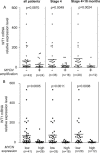WT1 expression is inversely correlated with MYCN amplification or expression and associated with poor survival in non-MYCN-amplified neuroblastoma
- PMID: 26482175
- PMCID: PMC5528963
- DOI: 10.1016/j.molonc.2015.09.010
WT1 expression is inversely correlated with MYCN amplification or expression and associated with poor survival in non-MYCN-amplified neuroblastoma
Abstract
Neuroblastoma (NB) is the most common extra cranial solid tumor in childhood and the most frequently diagnosed neoplasm during infancy. A striking feature of this tumor is its clinical heterogeneity. Several tumor progression markers have been delineated so far, among which MYCN amplification, which occurs in about 25% of total NB cases, with the percentage increasing to 30% in advanced stage NB. Although MYCN amplification is strongly correlated with NB of poor outcome, the MYCN status cannot alone predict all cases of poor survival in NB. Indeed NB without MYCN amplification (about 70-80% of NB) are not always favorable. WT1 was initially identified as a tumor suppressor gene involved in the development of a pediatric renal tumor (Wilms' tumor). Here, we describe an inverse correlation between WT1 expression and MYCN amplification and expression. However and most notably, our results show that WT1 gene expression is associated with a poor outcome for patients showing non-MYCN-amplified tumors. Thus WT1 expression is clinically significant in NB and may be a prognostic marker for better risk stratification and for an optimized therapeutic management of NB.
Keywords: Differentiation; MYCN; Neuroblastoma; Wilms' tumors.
Copyright © 2015 Federation of European Biochemical Societies. Published by Elsevier B.V. All rights reserved.
Figures




Similar articles
-
[Study on MYCN gene amplification and CD44 expression in neuroblastoma].Zhonghua Bing Li Xue Za Zhi. 2004 Aug;33(4):332-6. Zhonghua Bing Li Xue Za Zhi. 2004. PMID: 15363318 Chinese.
-
Clinical significance of MYCN amplification and ploidy in favorable-stage neuroblastoma: a report from the Children's Oncology Group.J Clin Oncol. 2008 Feb 20;26(6):913-8. doi: 10.1200/JCO.2007.13.9493. J Clin Oncol. 2008. PMID: 18281664
-
In vivo angiogenic activity of neuroblastoma correlates with MYCN oncogene overexpression.Int J Cancer. 2002 Dec 1;102(4):351-4. doi: 10.1002/ijc.10742. Int J Cancer. 2002. PMID: 12402304
-
Neuroblastoma and MYCN.Cold Spring Harb Perspect Med. 2013 Oct 1;3(10):a014415. doi: 10.1101/cshperspect.a014415. Cold Spring Harb Perspect Med. 2013. PMID: 24086065 Free PMC article. Review.
-
Neuroblastoma-derived v-myc avian myelocytomatosis viral related oncogene or MYCN gene.J Clin Pathol. 2023 Aug;76(8):518-523. doi: 10.1136/jcp-2022-208476. Epub 2023 May 23. J Clin Pathol. 2023. PMID: 37221048 Review.
Cited by
-
Emerging frontiers in epigenetic-targeted therapeutics for pediatric neuroblastoma.Front Immunol. 2025 Jul 25;16:1637626. doi: 10.3389/fimmu.2025.1637626. eCollection 2025. Front Immunol. 2025. PMID: 40787450 Free PMC article. Review.
-
A G316A Polymorphism in the Ornithine Decarboxylase Gene Promoter Modulates MYCN-Driven Childhood Neuroblastoma.Cancers (Basel). 2021 Apr 9;13(8):1807. doi: 10.3390/cancers13081807. Cancers (Basel). 2021. PMID: 33918978 Free PMC article.
-
FUBP1 promotes neuroblastoma proliferation via enhancing glycolysis-a new possible marker of malignancy for neuroblastoma.J Exp Clin Cancer Res. 2019 Sep 11;38(1):400. doi: 10.1186/s13046-019-1414-6. J Exp Clin Cancer Res. 2019. PMID: 31511046 Free PMC article.
-
WT1 Alternative Splicing: Role of Its Isoforms in Neuroblastoma.J Mol Neurosci. 2017 Jun;62(2):131-141. doi: 10.1007/s12031-017-0930-0. Epub 2017 May 22. J Mol Neurosci. 2017. PMID: 28534317 Review.
-
MicroRNAs at the Crossroad of the Dichotomic Pathway Cell Death vs. Stemness in Neural Somatic and Cancer Stem Cells: Implications and Therapeutic Strategies.Int J Mol Sci. 2020 Dec 17;21(24):9630. doi: 10.3390/ijms21249630. Int J Mol Sci. 2020. PMID: 33348804 Free PMC article. Review.
References
-
- Ambros, I.M., Amann, G., Ambros, P.F., 2002. Correspondence re: J. Mora et al. Neuroblastic and Schwannian stromal cells of neuroblastoma are derived from a tumoral progenitor cell. Cancer Res. 61, 6892–6898, 2001. Cancer Res. 62, 2986–2987; author reply 2988–2989. - PubMed
-
- Ambros, I.M. , Ambros, P.F. , 1995. Schwann cells in neuroblastoma. Eur. J. Cancer. 31A, 429–434. - PubMed
-
- Ambros, I.M. , Zellner, A. , Roald, B. , Amann, G. , Ladenstein, R. , Printz, D. , Gadner, H. , Ambros, P.F. , 1996. Role of ploidy, chromosome 1p, and Schwann cells in the maturation of neuroblastoma. N. Engl. J. Med. 334, 1505–1511. - PubMed
-
- Ambros, I.M. , Rumpler, S. , Luegmayr, A. , Hattinger, C.M. , Strehl, S. , Kovar, H. , Gadner, H. , Ambros, P.F. , 1997. Neuroblastoma cells can actively eliminate supernumerary MYCN gene copies by micronucleus formation–sign of tumour cell revertance?. Eur. J. Cancer. 33, 2043–2049. - PubMed
-
- Asgharzadeh, S. , Pique-Regi, R. , Sposto, R. , Wang, H. , Yang, Y. , Shimada, H. , Matthay, K. , Buckley, J. , Ortega, A. , Seeger, R.C. , 2006. Prognostic significance of gene expression profiles of metastatic neuroblastomas lacking MYCN gene amplification. J. Natl. Cancer Inst. 98, 1193–1203. - PubMed
Publication types
MeSH terms
Substances
LinkOut - more resources
Full Text Sources
Other Literature Sources
Medical

